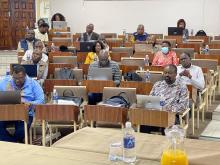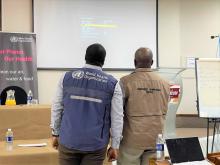Zimbabwe strengthens capacity to prevent, control and manage cholera and typhoid outbreaks
By Tatenda Chimbwanda
Kadoma, Zimbabwe – Zimbabwe has undertaken several activities to strengthen the country’s prevention, control and management of cholera and typhoid. For example, following a cholera outbreak in 2018, a National Task force for Cholera Elimination was created to support cholera elimination in Zimbabwe, through a multi-stakeholder approach. This task force spearheaded the development and launch of a Zimbabwe Multi-sectoral Cholera Elimination Plan 2018 – 2028. Cholera and typhoid, guidelines are essential tools for use by the Ministry of Health and Child Care (MoHCC) and key stakeholders to control the diseases. The current cholera guidelines were developed in 2009 and the typhoid guideline in 2011.
The MoHCC with support from Higher Life Foundation, Save the Children, World Vision and World Health Organization conducted a five-day workshop in Kadoma (12-16 December 2022) to update the third edition of the Zimbabwe cholera control guidelines and the first edition of the guidelines for Managing Typhoid Fever. The workshop, sought to align the cholera guidelines to support implementation of the Zimbabwe Cholera Elimination Roadmap 2019-2028, as well as update the guidelines for the management of typhoid fever in Zimbabwe in line with Global guidelines.
In his opening remarks, MoHCC, Epidemiology and Disease Control Deputy Director, Dr Isaac Phiri highlighted how updating these guidelines have been necessitated by a lot of changes that have occurred with regards to the treatment and management of cholera and typhoid in Zimbabwe and the rest of the world. For instance, new trends in anti-microbial resistance and new developments in vaccinations needed to be incorporated into the new guidelines.
“A number of health care workers have come into the system and these need to be capacitated with the new trends in these disease control, prevention and management,” he said.
The workshop’s main objectives were to review, update and validate the draft cholera control guidelines document that was last updated in 2019 (but not finalized) and the guidelines for the management of typhoid fever in Zimbabwe. Moreover, the cholera control guidelines would need alignment with new technical information that includes hotspot mapping, OCV coverage, risk assessment, surveillance, and outbreak response among others. The guidelines for the management of typhoid fever in Zimbabwe would similarly consider new technical information with particular focus on TCV and drug sensitivity pattens for appropriate treatment of cases.
“The guidelines will enable us to operate within a framework and guide on how to coordinate cholera and typhoid response. I look forward to learning how these guidelines will influence our responses and linkages with cross boarder initiatives,” added Mr Dube, Provincial Environmental Officer for Matabeleland South Province.
World Vision Health and Nutrition Technical Advisor Health and Nutrition Technical Advisor, Bhekimpilo Sithole envisions the updated Cholera and Typhoid guidelines to continue guiding and ensuring an effective, efficient, and well-coordinated response at all levels.
“These guidelines will ensure that Zimbabwe is aligned to international standards and best practices for cholera and typhoid control,” he said.
WHO, Zimbabwe Emergency Incident Manager Dr Lincoln Charimari noted how a multifaceted approach remains key to control cholera and typhoid, and to reduce deaths in Zimbabwe. He further reaffirmed WHO’s commitment to support Zimbabwe.







